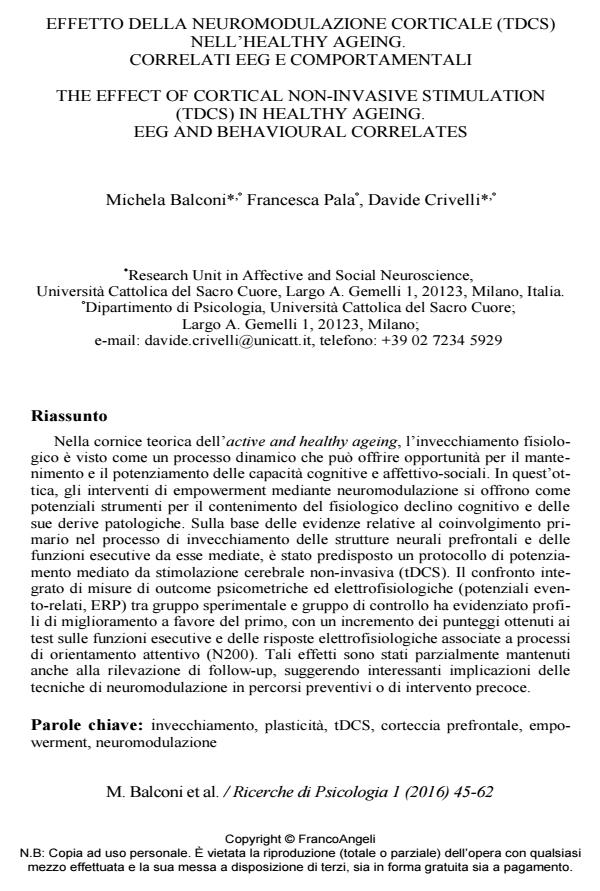Effetto della neuromodulazione corticale (tdcs) nell’healthy ageing. Correlati eeg e comportamentali
Titolo Rivista RICERCHE DI PSICOLOGIA
Autori/Curatori Michela Balconi, Francesca Pala, Davide Crivelli
Anno di pubblicazione 2016 Fascicolo 2016/1
Lingua Italiano Numero pagine 18 P. 45-62 Dimensione file 90 KB
DOI 10.3280/RIP2016-001004
Il DOI è il codice a barre della proprietà intellettuale: per saperne di più
clicca qui
Qui sotto puoi vedere in anteprima la prima pagina di questo articolo.
Se questo articolo ti interessa, lo puoi acquistare (e scaricare in formato pdf) seguendo le facili indicazioni per acquistare il download credit. Acquista Download Credits per scaricare questo Articolo in formato PDF

FrancoAngeli è membro della Publishers International Linking Association, Inc (PILA)associazione indipendente e non profit per facilitare (attraverso i servizi tecnologici implementati da CrossRef.org) l’accesso degli studiosi ai contenuti digitali nelle pubblicazioni professionali e scientifiche
Nella cornice teorica dell’active and healthy ageing, l’invecchiamento fisiologico è visto come un processo dinamico che può offrire opportunità per il mantenimento e il potenziamento delle capacità cognitive e affettivo-sociali. In quest’ottica, gli interventi di empowerment mediante neuromodulazione si offrono come potenziali strumenti per il contenimento del fisiologico declino cognitivo e delle sue derive patologiche. Sulla base delle evidenze relative al coinvolgimento primario nel processo di invecchiamento delle strutture neurali prefrontali e delle funzioni esecutive da esse mediate, è stato predisposto un protocollo di potenziamento mediato da stimolazione cerebrale non-invasiva (tDCS). Il confronto integrato di misure di outcome psicometriche ed elettrofisiologiche (potenziali evento- relati, ERP) tra gruppo sperimentale e gruppo di controllo ha evidenziato profili di miglioramento a favore del primo, con un incremento dei punteggi ottenuti ai test sulle funzioni esecutive e delle risposte elettrofisiologiche associate a processi di orientamento attentivo (N200). Tali effetti sono stati parzialmente mantenuti anche alla rilevazione di follow-up, suggerendo interessanti implicazioni delle tecniche di neuromodulazione in percorsi preventivi o di intervento precoce.
Parole chiave:Invecchiamento, plasticità, tDCS, corteccia prefrontale, empowerment, neuromodulazione
- Neurocognitive Empowerment in Healthy Aging: a Pilot Study on the Effect of Non-invasive Brain Stimulation on Executive Functions Michela Balconi, Laura Angioletti, Federico Cassioli, Davide Crivelli, in Journal of Cognitive Enhancement /2021 pp.343
DOI: 10.1007/s41465-020-00203-2
Michela Balconi, Francesca Pala, Davide Crivelli, Effetto della neuromodulazione corticale (tdcs) nell’healthy ageing. Correlati eeg e comportamentali in "RICERCHE DI PSICOLOGIA " 1/2016, pp 45-62, DOI: 10.3280/RIP2016-001004